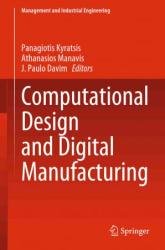 Название: Computational Design and Digital Manufacturing
Название: Computational Design and Digital ManufacturingАвтор: Panagiotis Kyratsis, Athanasios Manavis, J. Paulo Davim
Издательство: Springer
Серия: Management and Industrial Engineering
Год: 2023
Страниц: 266
Язык: английский
Формат: pdf (true)
Размер: 10.17 MB
This book presents the latest advances in computational and parametric design engineering, as well as digital tools related to manufacturing. It covers design and manufacturing process such as CAD-based design/manufacturing, parametric design, algorithmic design and process automation, and several digital tools and applications.
The continuous development of the graphical design environment allows returning to the graphical or grapho-analytical approach for the surface’s enwrapping problems, using capabilities offered by AutoCAD, CATIA, Solid Edge or other graphical design programs. In the present chapter, the method of “virtual pole” is presented and a program for profiling the generating tool was developed for the first time. The programs were written in Visual Basic for Applications (VBA), which allows profiling of tools like: rack-gear tool, gear shaped cutting tool or rotary cutter.
Using at large scale, the techniques for computer-assisted design, determining the development of some methods, which allows to the user to take the advantage of this techniques, when is necessary to determine profiles of tools which generate by enwrapping. For this, were imagined and published profiling algorithms which can be utilized for various CAD programs, as: AutoCAD, CATIA, Solid Edge, etc. The script presented at the end of this chapter is part of this effort. It was developed in VBA language and takes advantage of the CATIA design environment to profiling tools of type: reach-gear, gear shaped cutter or rotary cutter, designed to generate by enwrapping, using the rolling method, profiles known in analytical or discrete form.
The chapter "Augmented Reality-Driven Prototyping for Error Elimination During Computational Design and Digital Fabrication" proposes a methodology for small-scale prototyping using computational design and digital fabrication by incorporating Augmented Reality (AR), aiming at eliminating errors during the process. In the first stage, the chapter presents an algorithm for evaluating the accuracy of physical prototypes against digital design results, which have been developed in the context of an undergraduate course in computational design and digital fabrication. The errors that arise in each case are indicated based on quantitative and qualitative criteria. In the second stage, the process of fabricating corresponding structures by users with the participation of AR technology is proposed, providing a real-time correlation of the digital results with the physical outcomes throughout the fabrication process. Then, initial and new errors, which are occurred during computational design and fabrication, are compared, presented and discussed. Ultimate aim is the application of AR for eliminating errors in cases where computational design and digital fabrication incorporate human intervention.
While the well-established process of computational design to fabrication has been widely considered and its contribution has been recognized in many industries, it often appears to operate partially during the prototyping process. As a consequence, results are often unexpected and unsatisfactory in terms of required time or geometrical accuracy as well as costly as regard the required steps of the process. Moreover, specific design and fabrication processes cannot solely be carried out by using digital media, since the contribution of the human factor is inevitable. All the above often lead to major geometrical errors in the execution phase of the process and production of physical prototypes. Augmented Reality (AR) technology has been increasingly applied in the fields of architecture and construction industry the last few decades, especially in the context of the transition to Industry 4.0, which refers to the introduction of advanced technology and the digitization in the construction sector. The ability of AR technology to allow real-time interaction between the physical and digital environment and in particular its ability to project digital information that is visible to the users in the physical space allows the emergence of a range of advantages in terms of architectural design and construction processes.
Contents:
Generative Design in Architecture: From Mathematical Optimization to Grammatical Customization
Augmented Reality-Driven Prototyping for Error Elimination During Computational Design and Digital Fabrication
Design of Gesture-Controlled Interface for Mechatronic Systems: A Computational Approach
Topology Optimization Utilizing Density-Based Approach for Additive Manufactured Components: A Case Study of an Automotive Brake Caliper
Rethinking the Brick: Developing a File to Fabrication Framework for Mortar-Free, Robotic Masonry Wall Assembly
Knowledge-Based Design: A Function-Knowledge Reasoning Model for Product Conceptual Design
Equation Driven Micro-Milling of 2D Free Form Models and Off-Line G-code Generation for Variable Feed Machining
Study of the Topography of Face Milled Surfaces Using CAD-Based Simulation
Study on Design and Manufacturing of an Engine Block Using Digital Tools
Automatization of CAD Model Development of Slewing Bearing Using Solid Edg
CAD-Based Application in VBA for Tool’s Profiling
Скачать Computational Design and Digital Manufacturing